American Sabbatical 74: 3/20/97
Charleston
3/19.. More grits.
Wednesday morning we’d lost our oomph. Peggy was toured out and I was still twitching to the night
beat, so we declared a day off. We’d just hang out in Charleston
and be gracious. There’d been a downpour in the night, and it
was still muggy and overcast in palmetto country. The temps were
down in the 60s.. rugged.
|
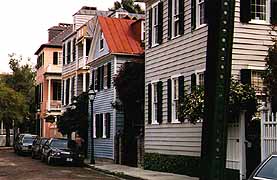
Old Charleston Street
|
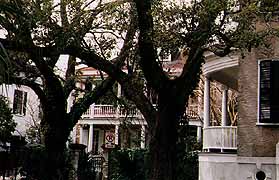
Battery View
|
The Owl crew had snooped out the parking situation yesterday,
and we snuggled the bird up against a wall down by battery park,
packed up our drawing supplies, and strolled into history. We’d
been at this game before: trying to find the perfectly emblematic
scene to draw. Let’s see.. palmettos and wisteria, balconies and
pastel stucco, wrought iron and shutters, horsecarts and cobblestones.
There never is one angle, of course, but the eager intensity of
framing everything in sight brings the world into vivid clarity. |
| A brick-paved alley arbored with lavender blossoms stopped us
at last, and we hummed happily over our imagemaking. An elderly
black woman in a faded blue and yellow plaid suit and a velvet
bowler hat stepped slowly and carefully over the teetered paving,
her hands daintily splayed out from the wrists, as if to insure
a safe landing. Other passing residents spoke us politely, and
we heard neighbors chatting over their floral barricades. The
houses we were drawing were early 1700s, and this was still a
living village, if you could afford it. |
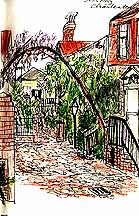
Peggy's Alley
|
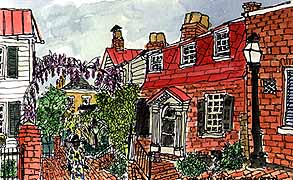
Bryce's Alley
|
Squads of tourists, afoot and in carriages, nikoned by to non-stop
commentaries from unlikely looking guides.. this one a college
professor, that one a street musician, another a finishing school
grad. All the horses (and mules) seemed to strut at their labor.
We’d worked up an appetite nibbling on camellias and azaleas,
so we followed our noses to restaurant row. |
| In fact there are more tempting eateries in Charleston than you
can shake a breadstick at: from classy cuisineries to catfish
fry factories. The lady who sold me Horry had recommended one
across the street as reasonable and delicious, and we pushed into
the old warehouse building ready to belly up to some fine Southern
cooking. |

Charleston Flowers
|
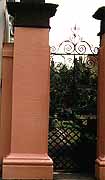
Gates & Pillars
|
We’d been feeling our way around this elephant some already. We’d
broken our teeth on some terrible hush puppies in a forgettable
roadhouse, and figured that was what shut the dogs up, then been
surprised by the tender sweetness of fresh ones in a “family restaurant”
in Georgetown. "Southern Fried Matzo-Balls!!" Peggy crowed. Tuesday
night I’d even been seduced by a bowl of grits in a cinderblock
Huddle House. We were ready for the downtown treatment. And we
weren’t disappointed. My shrimp and tomatoes on grits was luscious,
and Peggy’s breaded scallops on tender young salad set her to
moaning. The soy and ginger dressing on assorted leafcrops made
my ears twitch, and the key lime tart was just that. I've been
doing a research project on key lime ingestibles, on the theory
they converge with perfection as you approach the keys, and I
have yet to be proven wrong. This is important work. |
| The lunch crowd was quite elegant. Local matrons in outfits and
pearls, and the gents all in striped oxfords with natty ties (no
jackets). The tourists were almost ashamed in bermudas and polo
shirts, while we brazened it out in Owl garb. I’m sure my Lobster
Capital of the World T-shirt and safari vest wowed them. Maybe
the preciousness of this burg would get to you after a while,
especially if you had to commute to it from Super-8 City, but
we hummed out into the balmy with a fond feeling for Southern
hospitality. Even shared some banter with a bookseller about the
secondhand trade. She said she’d been to Maine, and couldn’t understand
how so many bookstores could survive. I said it was the long winters,
and the fact that Maine mothers cut pieces of lobster into the
shapes of letters to sharpen their children's appetite for learning. |

Cobblestones
|
Back on the Battery, the gnats decided to share in the hospitables,
and our afternoon artings were twitchy affairs until we’d given
the requisite blood. After a bit more cruising, we tottered back
to our pitstop on Golden Banana Ave, and settled back in for another
evening of light music, casual eavesdropping, and phosphorescent
typing.
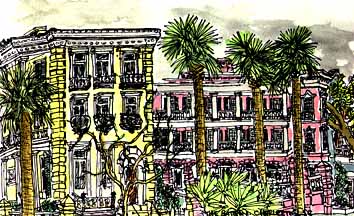
Bryce's Battery
(Memo #69)
March 20 Charleston Memo
Who? English and French Huguenot settlers, modern diverse population
What? major city-seaport of South Carolina with beautiful historica
district
Where? on peninsula where Ashley and Cooper Rivers meet bay
When? most important southern seaport in colonial times, major
tourist draw today
How? limitation of modern architecture
Topics: urban history, historic preservation
Questions: How do you preserve / restore urban areas? |
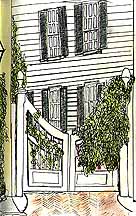
Peggy's Gate
|
It’s hard to write a formal historical memo about Charleston because
I found it a totally magical city where time stands still. How
to describe Oz? Atlantis? Kyoto? Charleston is beautiful, full
of pastel houses, live oaks hung with moss, and flowers. The azaleas
were in full bloom, filling parks and gardens and mews. Wisteria
winds around arbors and trellises. The houses are decked out with
columns and wrought iron and lanterns and gingerbread trim, ornamental
urns and lions and stone pineapples over gates. There are huge
mansions, four stories tall with great verandas and formal drawing
rooms glimpsed through long windows. There are tiny brick cottages
tucked into corners and carriage houses and rowhouses in vivid
pastels.
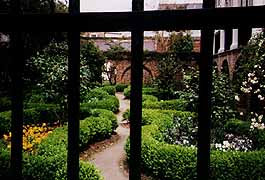
Gated Gardens
|
The historic district has almost no modern buildings at all. The
streets are narrow and commerce is almost invisible. The battery
area is entirely residential with an occasional small antique
shop or cafe. The shopping area is to the north. We walked for
hours, into courts and passages and squares and endless visual
delights. A cobblestoned alley would open into a sunlit square
with three hundred year old brick houses crowding in. A huge stucco
mansion would have a formal garden tucked in beside it. The sun
glanced off brass door knockers and tin roofs. Horse drawn carriages
clopped by. Charleston has the small touches of beauty that I
associate with English villages. Every corner has been lovingly
planted, polished, pruned. The trees are huge and old, streets
curve out around the biggest. |
Charleston has ugly industrial outskirts, but the oldest section
has remained surprisingly untouched by the modern world. Wilmington,
N.C., Savannah, Ga., St Augustine, Fla. all are a mix of old and
new; the oldest houses are next to parking garages or glass walled
offices. Some people might find Charleston overly prettified or
artificially preserved from the wear of time. I’m sure there are
extensive ordinances about house color and restoration that limit
a homeowner’s actions. Oldtown real estate costs the earth. And
it is all very beautiful.

Peggy's Battery
3/20.. Sumter.
A haunting silence fell over us around 2AM Wednesday night, and I jolted upright,
fearful that all economic activity had ceased in back alley Charleston.
Then I heard a 747 letting down through the mist, and was relieved.
After all this excitement camping is going to be very unsettling.
We put on our uniforms in the gray daylight, and marched our troops
down to the waterfront for a boatride to Fort Sumter. We hadn’t
realized it would be a full scale attack until the busloads of
middle schoolers debouched alongside us in the parking lot. What
joy. We knew we were in for it when the first dolphins appeared
alongside the Lady of Charleston, and the kids started screaming
and pointing. A Nam Vet standing beside me in a decorated baseball
jacket and cap (Sgt. .. Airborne), showed his teeth, and the kids
backed off from his patch. I wondered which war we were revisiting.
The tour guide whose commentary was competing with the ululating
teens gave a delicate spin to the story of Sumter, and you’d have
been puzzled to get a knife between the blocks of his account
to pry the Yankee side from the Confederate. In fact that war
may almost be over. I can remember encountering anti-Yankee prejudice
30 years ago, but have yet to sniff a trace of it down here now.
Anti-hairball suspicions, maybe, but any of the old rebel yelling
hasn’t been in my hearing. Even Confed flags are scarce, so far.
(Although we did see one with shamrocks instead of stars on Patty’s
day). Another cost of assimilation to the American way: the end
of regional pride?
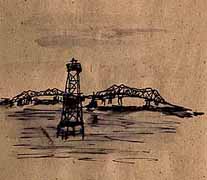
Charleston Bridges
Once out in the confluence of the Ashley and the Cooper you realize
how different Charleston is from other cities. No highrises. The
battery and old city must have looked much the same way in 1860
as it does today. The industrial landscape beyond that would have
confused the troops, and those four double-cantilevers struck
them dumb. In these alluvial lowlands, the great bridges are monumental,
fulfilling a need for grandeur as well as synaptic integration.
Sumter itself, like so many historic monuments, has been dwarfed
by history. The big container ships coming into port, trailer
bodies piled 6-high, loom up behind the old ruin as you approach
it, and make it seem tiny. What had been imposing walls, three
gun-tiers high in the old "Harper’s Weekly" engravings (looking
like Ft. Popham), were reduced to rubble by bombardment. Now only
a single tier of batteries remains, and I roamed about outside
trying to get an angle to illustrate a sense of what’s left.
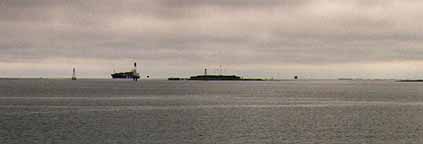
Container Ship dwarfs Sumter
Giving up, I found a perch inside on an embankment where I could
draw an emplaced gun and a view over the parapet. Where I was
pounced on by a park ranger who badmouthed me for breaking the
rules of engagement. These had been issued over the hubbub of
teens, so I’d missed the fine points. I had heard him insist that
the school groups stay together with their teachers, which didn’t
even bring a laugh, the kids simply scattered. So the ticked enforcers
could only insult adult visitors. I was bad acting again, I admit
it.
(Memo #66)
March 18 Fort Sumter - Charleston S.C.
Who? Union and Confederate Troops
What? fort where the Civil War (War Between the States) began
Where? artificial island in mouth of Charleston Bay, S.C.
When? April 12, 1861
How? Confederate batteries around Charleston Bay fired on Fort
Sumter
Topics: Civil War - causes and start
Questions: Why did the Civil War open with the firing on Fort
Sumter, S.C.? Why there? What happened to the fort? Is Fort Sumter
a preservation? A recreation? |
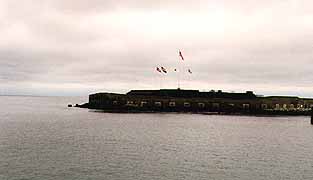
Fort Sumter
|
Every American history textbook reproduces the "Harper’s Weekly"
illustration of the firing on Fort Sumter. The first shell, fired
before dawn on April 12, 1861, explodes brightly over the island
fort. It is the last event in the chapter on the buildup to the
Civil War.
Fort Sumter is in the mouth of Charleston Bay. From the city’s
battery walk it is a distant shape on the southern horizon. Its
construction was spurred by the British invasion and burning of
Washington D.C. in the War of 1812. The US government realized
how vulnerable our coast was and began building a series of forts.
To augment the three forts on the land sides of Charleston Bay,
an artificial island was constructed with a nine foot base of
MAINE GRANITE (70,000 tons) from Penobscot Bay dumped on a shoal.
The construction started in 1829 and was 90% completed when the
Civil War broke out (but only 15 of the 65 guns were mounted)
Fort Sumter itself is a pentagon shape perhaps a hundred yards
across with brick walls five feet thick and fifty feet high. Three
story brick buildings stood against several sides.
Today Fort Sumter is a half hour boat ride from the Charleston
City marina. We boarded from a marina by a renovated rice mill.
The boat took us past the spectacular houses along the Charleston
shore and a dolphin swam around the ship as we moved down the
bay. The boat docked on the city side of the fort and we entered
though the ground level sally port. The original brick buildings
are gone but foundations show their walls and rooms. The gunholes
in the outer walls have been cemented shut. A huge steel building
on the south side of the parade ground houses the museum, gift
shot, amenities. Several original cannons are on the parade ground.
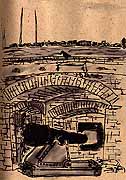
Bryce's Sumter
|
Fort Sumter has not been totally restored, nor has it been left
in its post Civil War ruin. It was repaired and refitted with
larger cannons during the Spanish American War. There was obviously
some cleanup and some reconstruction, but the original brickwork
is shown. The guides termed it a “stabilized ruin” (other historic
sites are “restorations” or “preservations” or total “recreations”). |
Abraham Lincoln’s election in November 1860 was a turning point
for the South. In December South Carolina became the first Southern
state to secede. South Carolina’s leadership was natural; not
only was it the richest of the Southern states, but it already
had lead a secessionist / states rights struggle under President
Andrew Jackson thirty years earlier which was averted when Jackson
threatened to send the army in (!). In the four months between
Lincoln’s election and inauguration, the secessionist states started
to seize federal posts throughout the South. By April 1861, only
Fort Pickens and Fort Sumter remained under Union control.
Major Robert Anderson was commander of the Union forces around
Charleston Harbor, based at a Fort Moultrie on the east side of
the bay. In an act the South saw as provocative, Anderson secretly
moved his 85 troops to Fort Sumter and set men to mounting guns.
The Union flag flew over the mouth of the Bay.The South seized
the mainland forts, trained their guns on Sumter, and began erecting
other batteries around the Bay. Fort Sumter’s supplies would eventually
give out. The 45 women and children in the fort were evacuated
for the North in February. President Buchanan sent boats with
supplies which were turned back by Confederate boats.
Fort Sumter was the focus of attention when Lincoln was sworn
in. Lincoln decided to send boats with relief supplies for Fort
Sumter, and notified the South Carolina Governor. The Confederate
cabinet voted to resist resupply of the fort. General Beauregard,
in command of the Southern troops at Charleston, demanded evacuation.
Anderson offered to do so several days later, knowing Union ships
were on the way. During the night of April 11 Anderson was told
bombardment would began before dawn. He refused to surrender.
Firing started at 4:30 a.m. Anderson did not return fire for several
hours.
| Anderson had several problems. His guns required five man crews.
He needed double crews to fire round the clock. At most eight
to ten cannons could be put into action against the many batteries
on shore. This number proved impossible as Confederate shells
started fires in the fort and Anderson’s men had to fight them.
The smoke became impossible and there was danger of fire setting
off the three hundred barrels of powder stored in the magazine
Three thousand shells were shot at Fort Sumter. The bombardment
went on for thirty-four hours before Anderson surrendered. No
one was killed in the action. Interestingly, the South allowed
the troops to evacuate for the North. The retaking of Fort Sumter
by the Union required twenty-two months from 1863-65. |

Peggy's Sumter
|
There are many explanatory signs around the fort and an excellent
museum. The steps and tools needed to fire the guns are well explained.
The battered flag that flew over the fort during the bombardment
is hanging on display. A monument lists all the soldiers under
Anderson’s command, with names ranging from McGuire to a Jeff.
Davis. Their jobs were listed; they ranged from musician and assistant
surgeon to artificer. I was interested to find Ann Amelia Weitfieldt
listed as matron. Was she there during the bombardment?
The outer walls still show the shell marks of April 12, 1861.
Fort Sumter is one of the most vivid sites we’ve visited. History
lingers.
3/20.. cont.
The island assault was blessedly brief, and as at Alcatraz, we were happily herded
back on board. It was still nippy in the roads, and we were glad
we’d dressed like Mainers. It’s funny to see that we don’t really
trust the sunshine. Even on balmy days we have an extra layer
aboard, and look like Eskimos in the shirtsleeved crowd.
Once the dolphins had led us back to the wharf, we opted for one
last linger in this beautiful old city, and we found a parking
space alongside the old market. It's the battered hulk of a Greek
Revival temple, with steep steps up to the chipped pillars and
portico. Street teens were nodding out on the steps. Inside, vendors
have installed petitioned stalls creating an airy serpentine mall.
Peggy got hooked at the hat store, where she tried to fit me into
a Panama, but the Rhett Butler Look just doesn’t suit. She did
find a replacement for the summer sun hat she’d lost somewhere
in the Adirondacks last September. Just shows you how inconsistent
our economies are. We’ll drop a fistful of dollars on a meal one
night, but stint ourselves on a sunhat for 7 months. I went the
whole first trip using a pair of $2 sunglasses I’d broken the
nose-piece on the first day out. Just couldn’t bring myself to
splurge on another pair. Now I’m using another old set from home
that are so scratched I can hardly see through them (but they’re
so comfortable). It took Peggy half an hour deciding to buy a
$15 hat, and we almost got a $30 ticket in the process.
We jammed some more quarters in the meter and went looking for
crablegs. Pushing our luck. We found a cheap menu at the Oyster
Factory, and got what we paid for, along with reggae and CNN for
multimedia. Oops, scuse us, gotta go. Goodbye Charleston, hello
Highway. At least as far as the next plantation.















